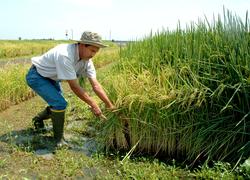Fayetteville, Arkansas
March 11, 2008
|
 |
Dr. Rusty Bautista,
post doctoral research associate, collects samples of
rice in a research project to determine the effects of
night time air temperatures and moisture content at
harvest on the milling and functional quality of rice.
Photo by Howell Medders
|
 |
Research technician
Mohammed Saleh, left, and Dr. Jean-François Meullenet,
associate professor of food science, use a near-infrared
diode array analyzer to predict quality characteristics
of rice samples. Photo by Fred Miller
|
Scientists in the
University of Arkansas
System's Division of Agriculture are taking a systematic
approach to research on issues of post-harvest rice quality.
Several lines of research, beginning with the effects of
nighttime air temperatures and moisture content at harvest on
post-harvest quality, are coming together to give rice breeders,
growers and processors critical information to improve rice
varieties and products. The information will also help growers
and processors make decisions aimed at improving the returns on
their production investments.
Food scientists Terry Siebenmorgen, Jean-François Meullenet and
Ruben Morawicki are joining forces with rice physiologist Paul
Counce and rice breeders Karen Moldenhauer and James Gibbons in
a research effort supported by the Arkansas Rice Research and
Promotion Board.
“Harvest moisture content and nighttime temperatures during
kernel development typically make a huge impact on milling and
functional quality,” Siebenmorgen said.
Milling quality refers to how rice kernels stand up to drying
and the milling process — the degree to which they break apart
or remain intact. Functional quality influences how the rice
will behave during processing into food products, including
parboiling or “puffing” for cereal.
Siebenmorgen’s assertion is based on five years of data
collection. His qualifier, “… typically,” is the target of
ongoing research to identify the environmental factors that
contribute to the impact of harvest moisture content.
Linking up with Moldenhauer and Gibbons, who supervise the
Arkansas Rice Performance Tests (ARPT), and Counce, who provides
growth stage analyses, Siebenmorgen will examine the impact of
nighttime air temperatures and varying levels of moisture
content on six varieties and hybrids of rice grown in Arkansas.
“Drs. Moldenhauer and Gibbons are adding three extra
replications of each of six specific entries in the ARPT plots
at each of six different Arkansas locations.”
Samples from each of those additional replicated plots will be
harvested at six different moisture contents, Siebenmorgen said.
Two sensors that record nighttime temperature and relative
humidity from 50 percent heading to final harvest will also be
located at each location.
“Primarily, we want to quantify how bulk physical and chemical
properties, and the kernel to kernel distribution of those
properties, change at different moisture contents,” Siebenmorgen
said.
Six samples from six varieties at six locations, all replicated
three times, will result in hundreds of samples. The timely
harvest of these samples at six, spread-out locations represents
a tremendous challenge that is being met by Rusty Bautista and
Redentor Burgos, rice scientists in the Rice Processing Program.
Siebenmorgen will be looking at how these samples perform in
drying and milling tests. Meullenet will study the impact of
harvest moisture content and nighttime temperatures on
functional and sensory quality and Morawicki will study the
impact on cooking quality.
The chemical tests required for the functional quality study
alone would require hundreds or thousands of hours of lab work
using conventional chemical analysis, Meullenet said.
To speed things up, Meullenet uses a near-infrared diode array
analyzer that can predict results for milling quality
characteristics with a six-second test.
The instrument exposes rice samples to near-infrared light of
different wavelengths and measures the difference between light
absorbed and light reflected by the sample, Meullenet said. The
results are indicative of chemical characteristics in the rice.
Meullenet is working on developing calibrations that will also
give accurate results for functional quality characteristics.
The most important of these for functional quality are texture,
viscosity of rice flour and protein content.
Meullenet and research technician Mohammed Saleh are testing
rice samples from the variety testing program at Riceland Foods
and comparing the results against those measured by conventional
chemical tests already performed by Riceland.
“Riceland tests about a thousand samples a year using
conventional chemical tests performed by three full-time
technicians,” Meullenet said. “Once we determine the proper
calibrations, we’ll be able to test that many samples in a day.”
His goal will be to develop prediction calibrations that will
grade rice samples in relation to a “gold standard” of quality,
like Bengal, a rice variety considered to have near ideal
quality for some food applications involving puffing.
Siebenmorgen and Meullenet also want to make the massive and
growing trove of rice quality data easily accessible to growers
and processors, who can use it to make decisions about choice of
variety, most cost effective harvest moisture content and other
considerations. Rice breeders can also use the data to help
evaluate a breeding line for its potential as an improved
variety.
The team is developing a Web site that will allow easy,
searchable access to the data, Siebenmorgen said. They also
would like to develop a spreadsheet program that will allow
growers or processors to input variables, such as variety or
hybrid, growing location and drying costs, and provide
historical data on properties and processing qualities.
“It’s a tool for determining which decisions will help hit an
‘economic peak’ for producers and processors,” Siebenmorgen
said.
“The great thing about taking this systematic approach,”
Meullenet said, “is the integration of the effort across
disciplines. And we’ll be able to follow the performance of
specific rice varieties year after year.” |
|